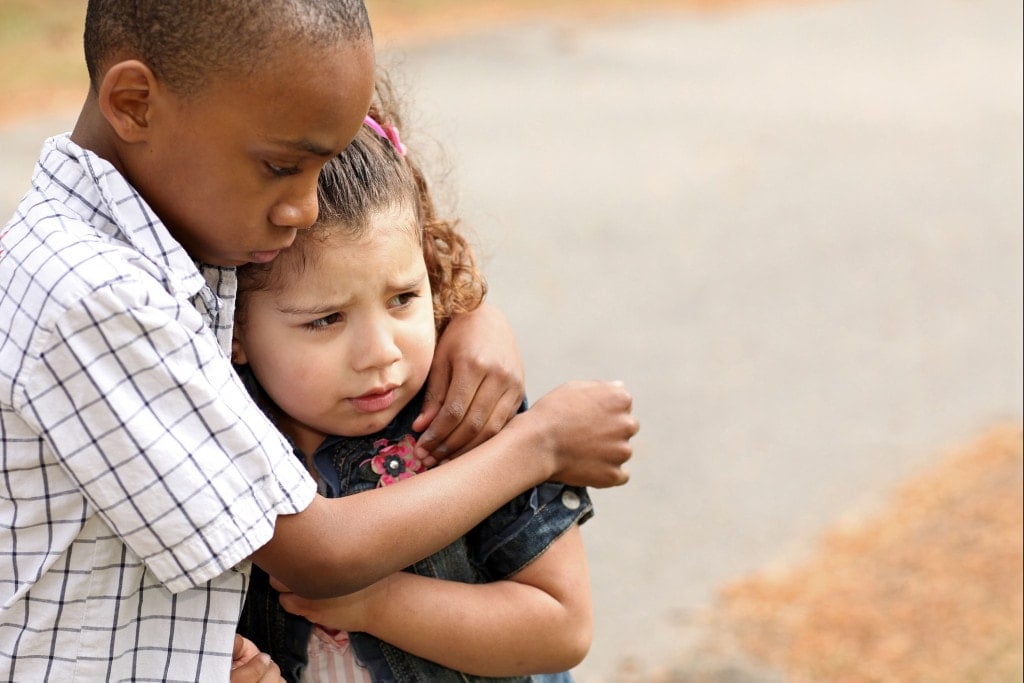Empathy is a word we hear often. Many parents are concerned about teaching kids empathy or how to explore teaching it when raising their children. “Stick and stones” and “Put yourself in someone else’s shoes” are common phrases parents can use to get their children thinking about their actions and how they impact others. Teaching empathy is something we do from the moment our children are born without even realizing it. For instance, we say things like, “Use gentle hands” or “Pat the puppy gently.” With instructions like these, we start planting the seeds of empathy in our children early on.
But what is empathy all about? And why is it so important to teach our children to be kind and considerate of other people and their feelings? In this article, we’ll explore how children develop empathy and share steps you can take to help them.
What Is Empathy?
Empathy is putting yourself in someone else’s shoes and understanding their feelings. It’s a skill that helps us socially and emotionally as we use our experiences to understand the world around us and navigate social situations. We use our knowledge to help us decide how to respond to people because we understand their feelings and what they might need or want.1
Why Is Empathy Important?
Empathy is an essential life skill for our children to possess, and it is linked with something called “emotional intelligence.” Emotional intelligence is the ability to understand our own feelings and others’ feelings and manage our emotions or respond to people in socially appropriate ways.2 Empathy skills are beneficial because they:2,3
- Help children be tolerant of others
- Increase social harmony and build strong, secure relationships with people around them (because they can better manage conflict and understand and communicate with others)
- Increase a sense of happiness and general well-being
- Lower stress levels
- Lead to increased success later in life, personally and professionally
- Help children become better at regulating and managing their emotions
When Do Children Develop Empathy?
When children are young, they are naturally egocentric. This means they typically think about themselves and their own needs. It’s not that they are mean or “bad.” They haven’t yet learned the skills that allow them to consider the needs and feelings of others.4 However, children are born with a certain innate level of empathy. But it’s more about a desire to be good or help people than genuine empathy.
Milestones in Empathy
Teaching empathy doesn’t happen overnight, and our children typically need to reach a certain level of development before they can truly understand others’ emotions.4 There are four key stages in developing empathy:5
- Noticing/Emotional contagion. This is an instinct where another person’s feelings evoke the same emotion in us. This happens when we watch a sad movie and cry alongside the character. It isn’t conscious; it’s an instinct. And we are simply observing.
- Correctly interpreting. We pay attention to or observe another person’s feelings. We increase awareness but don’t necessarily feel or truly understand the feeling.
- Feeling the same emotion. This stage is focused on feeling and understanding other people’s emotional experiences.
- Responding to the emotion. We understand the feelings of others, and we use this information to help us support or respond to that person’s emotions.
By age 2, children typically exhibit some fundamental empathy — they have an emotional response that corresponds with another person’s feelings (stage 3). Although children from as young as 18 months show signs of empathy (i.e., comforting someone who is crying), they don’t develop something called “theory of mind” until the age of 4.6 Theory of mind is being able to understand that other people have different beliefs and experiences from their own. From age 4, empathy continues to grow and develop into adulthood.6
Can Empathy Be Taught?
Absolutely! While empathy at some level is something we are naturally ingrained with, teaching empathy can also occur through experience and repetition. This means that early childhood experiences and parenting strategies can structure how to build empathy and, in turn, assist our children to become compassionate, kind people.
How To Teach Empathy
One of the most critical elements of teaching empathy is modeling and repetition. Children learn about empathy because they can practice and receive it.2 So, how you interact with and raise your child will directly influence their capacity for empathy. Here are some specific ideas for training or supporting your child to develop empathy:
1. Walk the Walk
When teaching empathy, you must show your child what you expect from them. Show your child empathy, and demonstrate it with others in your life. Essentially, be a role model so they can see what you expect and how to learn and practice this new skill.
2. Teach Your Child About Emotions
Name feelings when you see them in your child, label feelings as you experience them, or identify feelings you see in others. Use many “feelings” words; for example, sadness has a range of feelings, from flat to devastated. The more words you give your child, the better equipped they will be to understand their and others’ experiences.
3. Help Your Child Manage Big Feelings
While it’s normal for our kids to experience intense or negative emotions (anger, shame, etc.), we must teach them how to manage them. If they can manage them in productive, positive ways, they will be better able to problem-solve and have stronger emotional intelligence (linked with empathy).2
4. Try Empathy Activities for Kids
Activities for teaching empathy include things like:
- Reading stories: This gets children to consider other people’s lived experiences. You could read a book and ask them questions to get them thinking, such as, “I wonder if that made that person feel sad?” or “I wonder how they feel about XYZ?”
- Playing with toys: Other activities could be as simple as providing toys your child can care about. For instance, playing with baby dolls.
- Dressing up: You could also provide them with costumes or dress-up items for compassionate/empathy roles (doctors, nurses, vets, teachers, etc.) so they can practice empathy skills during play.
- Role-playing: You could also role-play scenarios to get them to practice empathy. For example, play a board game; if you lose, you can tell them you feel upset and that it’s normal to feel upset when you don’t win. Ask them what they do to help them feel better. You can then practice the skill or strategy they share.
- Drawing emotions: Drawing can be a great way to teach kids about emotions. You could draw a heart and ask them to draw what feelings they have in their heart. They could also draw what they think an emotion looks like or color in an outline of a body and explain where they think different feelings exist within their body.
Developing empathy is an essential part of child development. It helps our children successfully navigate the social world and improves their mental health and well-being. Just remember that teaching empathy takes time. Your child won’t perfect the skill overnight; some adults haven’t fully mastered these skills. So, be kind (and empathetic) with your little one as they build this skill, and have patience, as it is complex and will continue to develop across their lifespan.


































